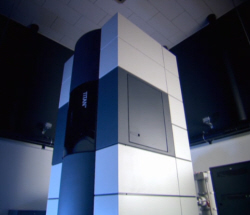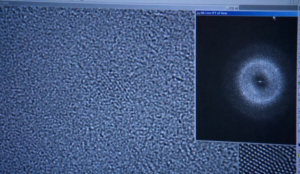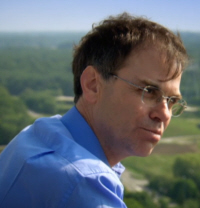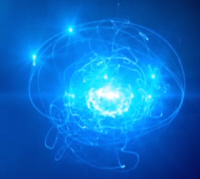PICO Microscope
the Large Hadron Collider
Horizon - small Universe

PICO Microscope
As microscopes have got bigger and more powerful, they have allowed us to peer ever smaller. It was the ancient Greeks who first dreamed of the idea of
atoms. 100 years ago, scientists proved they exist. But it's only in the last ten years that we've actually been able to see them.
And now, behind these doors, Joachim Mayer has a machine that gives us the best possible view.
Professor Joachim Mayer "It looks like a giant coffee maker! So this is the new PICO instrument, which has been installed about a year ago. And with its
special new corrector for the chromatic aberration, is really a very unique machine which really offers us new possibilities. I think with its new
capabilities, we consider it as the best electron microscope in the world."
Being the best electron microscope in the world, PICO is very sensitive to its surroundings. Even a person's body heat would disturb it, so PICO has
to be operated remotely. And, safely isolated from humans, PICO is able to unveil the secret world of the very small.
Joachim Mayer "We start our investigations at a very small magnification, which is equivalent to the highest magnification, which you can actually
reach with a light microscope. At this magnification, the diameter of a human hair would be about one metre. And now we can in magnification go at least
a factor of 1,000 higher. And now we start to see the structure, actually these black dots are individual gold nanoparticles. And now you can see the
individual atoms as they appear in this individual nanoparticle. So we see individual atoms aligned in the structure."

Gold nanoparticles
It's hard to imagine just how small these dots of matter really are. But consider that each of us contains about seven billion, billion, billion
atoms. That's more than the number of stars in the entire universe.
PICO is, quite simply, the most powerful microscope in the world. After magnifying things a billion times, we can actually see the individual atoms
that make up everything in the universe. This is the smallest thing we can see. It may well be the smallest thing we'll ever be able to see. These
atoms look reassuringly like what you'd expect – solid round balls of stuff. But this is merely an illusion.
If you want to find out what an atom really looks like, you need a whole new way of looking. Professor Andy Parker is trying to find things
smaller than anyone has ever found.

Andy Parker
Andy Parker "Well, the way to look inside an atom is to fire something at it very fast, if you hit it hard enough you can break it into little bits."
He is using the most expensive experiment in the history of physics, one he helped design. At 17 miles long, and buried 100 m underground, it is the
biggest and most famous particle accelerator in the world – the Large Hadron Collider.
But once you start looking inside an atom, nothing is what it seems.
Andy Parker "People always imagine atoms as billiard balls, they've seen pictures of atoms as billiard balls or with a little electron going
round quite a big nucleus, and this is a completely false picture. If you blew up an atom to the size of the large Hadron Collider, then the
nucleus would be about 10 cm across, about the size of a tennis ball. So all the mass, all the weight of the atom is condensed into this tiny
little nucleus, and the whole space around it is empty, apart from those few electrons buzzing around."

Fuzzy Cloud of Electrons
The illusion of solidity comes from the fuzzy cloud of charged electrons. But on their own, they weigh virtually nothing and occupy no space. You
need to go 100,000 times smaller to get to the nucleus – a fizzing ball of protons and neutrons. The challenge here at the LHC, is to look inside
protons by smashing them to pieces.

Nucleus, Protons & Neutrons
Andy Parker "It's brute force and ignorance really. You are taking two things, which are very, very small, you don't really know what's inside them
to start with, and you hit them together as hard as you can and this march into tiny fragments and since you really don't know what the elaborate
structure is inside, it's kind of like colliding two clocks together and then sweeping up the mess that you get and trying to figure out how the
clock works. And you can't do it in a subtle way. There's no screwdriver to take a proton to bits and there is no plan of what's inside so you have
to hit them very hard, then the fragments come flying out and from that we can try and work out, and all the cogs and gearwheels fit back together
to make a proton."
The debris from the proton collisions is detected by a vast machine called ATLAS.
Andy Parker "Everything interesting happens at the centre, that's where the particles collide."
This engineering mock-up shows just one section of the real machine. And the sensitive instrument at its very heart is the part made by Andy.
Andy Parker "So I'm in the middle of the mock-up of ATLAS, and this is where all the action happens. The beans should come in from both ends through
the centre here. This would of course be filled with detectors, but the beam pipe would run right through the centre and the particles, which are
travelling in vacuum at almost the speed of light, collide head-on just here, and do their stuff and then all the debris comes flying out and advise
through the detector layers… And that's the debris that we use to reconstruct the collision that happens right here in the middle."
And what you find when you smash a proton to pieces, is that it too is largely empty space. It is made of three tiny fundamental particles called
quarks. But to reach the size of a quark would have to zoom in 1,000 times smaller.





